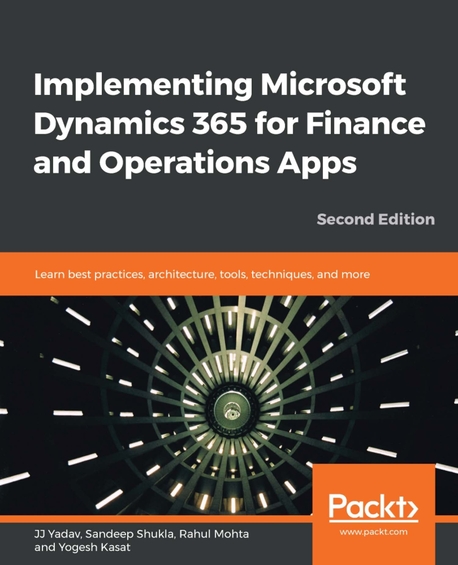Implementing Microsoft Dynamics 365 for Finance and Operations Apps Second Edition
2020년 03월 06일 출간
- eBook 상품 정보
- 파일 정보 PDF (37.48MB)
- ISBN 9781789954142
- 지원기기 교보eBook App, PC e서재, 리더기, 웹뷰어
-
교보eBook App
듣기(TTS) 가능
TTS 란?텍스트를 음성으로 읽어주는 기술입니다.
- 전자책의 편집 상태에 따라 본문의 흐름과 다르게 텍스트를 읽을 수 있습니다.
- 이미지 형태로 제작된 전자책 (예 : ZIP 파일)은 TTS 기능을 지원하지 않습니다.
PDF 필기가능 (Android, iOS)

쿠폰적용가 21,600원
10% 할인 | 5%P 적립이 상품은 배송되지 않는 디지털 상품이며,
교보eBook앱이나 웹뷰어에서 바로 이용가능합니다.
카드&결제 혜택
- 5만원 이상 구매 시 추가 2,000P
- 3만원 이상 구매 시, 등급별 2~4% 추가 최대 416P
- 리뷰 작성 시, e교환권 추가 최대 200원
작품소개
이 상품이 속한 분야
Microsoft Dynamics 365 for Finance and Operations is a modern cloud ERP platform that adopts a mobile-first approach suitable for medium-to-large enterprises. This book covers the entire implementation process of Dynamics 365 Finance and Operation Apps, including post-implementation and business transformation.
The updated second edition starts with an introduction to Microsoft Dynamics 365, describing different apps and tools under it. You will learn about different implementation methodologies such as Waterfall and Agile, for your projects. We will cover various application components and architectures of Dynamics such as requirements processing, development, reports and analytics, and integration. With the help of tips, techniques, and best practices, you'll explore strategies for managing configurations and data migrations. As you read further, you'll discover development tools and processes in Dynamics for building customized solutions in Dynamics. The book will also demonstrate analytics and financial reporting options such as Power BI and Cortana Intelligence. Finally, you'll learn the importance of testing and explore various automated testing strategies.
By the end of this book, you will have gained the necessary knowledge to implement Microsoft business solutions with Dynamics 365 for Finance and Operations Apps.
▶What You Will Learn
- Understand the architecture of Dynamics 365 for Finance and Operations Apps
- Implement Dynamics with confidence to manage finances in your business
- Get up to speed with different methodologies and support cycles of the Microsoft Dynamics architecture
- Explore best practices to analyze the requirements of your business
- Understand the technique of data migration from legacy systems
- Leverage the capabilities of Power BI to make informed business decisions
- Manage all your upgrades through One Version service updates
▶Key Features
- Manage and plan different Dynamics configurations, designs, and products
- Learn how to manage projects for pre-sales and implementation using Microsoft Dynamics Lifecycle Services (LCS)
- Discover various integration planning techniques, tools, and frameworks such as PowerApps and Power Automate
▶Who This Book Is For
This book is for consultants, technical managers, project managers, or solution architects who are looking to implement Microsoft Dynamics 365 Finance and Operations apps in their business. A basic understanding of the enterprise resource planning (ERP) implementation process and software lifecycle is expected.
1. Introduction to Dynamics 365 Finance and Operations
2. Methodology and Initiation
3. Lifecycle Services (LCS) and Tools
4. Architecture, Deployment, and Environments
5. Requirements and Process Analysis
6. Configuration and Data Management
7. Solution Planning and Design
8. Integration Technologies, Planning, and Design
9. Customization and Extension
10. Analytics, Business Intelligence, and Reporting
11. Testing and Training
12. Managing Go-Live and Post Go-Live
13. One Version Service Updates
▶What this book covers
- Chapter 1, Introduction to Dynamics 365 Finance and Operations, introduces you to Microsoft Dynamics 365 and shares details of various applications. This chapter also describes Finance and Operations basics, core capabilities, deployment options. It describes using AppSource which is one of Microsoft portals to find ISV independent software vendor solutions as well list of partners who could help customers implement Dynamics 365. It also describes how to sign up for a free trial and the ERP implementation team structure.
- Chapter 2, Methodology and Initiation, shares information on various implementation methodologies, such as CRP, Agile, and Waterfall for selection, implementation, and maintenance of Finance and Operations.
- Chapter 3, Life Cycle Services (LCS) and Tools, introduces Life Cycle Services (LCS) and tools and how they are used to manage your application life cycle from project on-boarding to the implementation and operation of the project.
- Chapter 4, Architecture, Deployment, and Environments, explains the Finance and Operations application components and architecture, as well as deployment choices such as cloud and on-premises deployment. It also covers cloud deployment and various aspects of environment planning.
- Chapter 5, Requirements and Process Analysis, explains the need for capturing requirements well in SMART (short for Specific, Measurable, Achievable, Realistic, Time-bound) format. This chapter also covers requirements, processes, solution blueprints, and emphasizing the needs of business process and various other aspects of managing the scope of the project.
- Chapter 6, Configuration and Data Management, helps you explore configuration management and data migration, data management tools, data management frameworks, data management scenarios, and best practices in managing configurations and data migration.
- Chapter 7, Solution Planning and Design, helps you plan and execute functional design and technical design. It also contains tips and tricks with real-life examples of design patterns―both good and bad―to support best practices.
- Chapter 8, Integration Technologies, Planning, and Design, covers integration planning and the integration tools and frameworks available in Finance and Operations, as well as best practices for integration design.
- Chapter 9, Customization and Extension, helps you explore the things that you need to know before starting development, during development, and after development, such as the development environment, tools, technical concepts, build and versioning strategies, the development process, frameworks, best practices, and automated build and deployment processes.
- Chapter 10, Analytics, Business Intelligence, and Reporting, covers the BI and reporting scenarios and tools. The chapter also covers how to use Azure Data Lake and Azure Synapse Analytics to define the analytics data strategy and integrations. It also explains the best practices in analytics, business intelligence, and reporting.
- Chapter 11, Testing and Training, helps you understand the new features and techniques of testing. It also takes you through different testing scenarios and shows the readers some of the best practices in testing and training.
- Chapter 12, Managing Go-Live and Post Go-Live, helps you to plan for a successful go-live and explains how you can support a production environment.
- Chapter 13, One Version Service Updates, explores Finance and Operations One Version through topics such as update availability, update early adoption, service updates, quality update, and feature management.
▶ Preface
Microsoft Dynamics 365 is a cloud-based business application platform consisting of purpose-built intelligent applications that unifies ERP and Customer Relationship Management (CRM). Part of Dynamics 365, Finance and Operations is a modern cloudbased ERP platform that helps you manage financials, manufacturing, and supply chain operations in a medium to large organization.
This book is written from the perspective of the ERP implementation team, encompassing everything required to achieve a successful implementation of Finance and Operations apps. You will deep dive into various aspects of Finance and Operations implementation and learn about best practices, architecture, tools, life cycle management, deployment, support, and maintenance.
This second edition is updated with the latest developments in Finance and Operations applications and technology. The book starts with an overview of Finance and Operations applications, life cycle services, implementation methodologies, application architecture, and deployment choices.
As you progress, you'll learn about requirement and process analysis, integration planning techniques, configuration and data management, as well as custom solution design and customization. This book demonstrates analytics and financial reporting capabilities and integration with Power BI and Azure Data Lake.
Toward the end of this journey, you'll understand the importance of testing and training and go-live planning. Managing predictable and continuous updates through One Version is the final takeaway from this book.
인물정보
저자(글) JJ Yadav
JJ Yadav has 16 years of consulting experience working on ERP systems and implementations, and has been working since Axapta 3.0. He has worked with Microsoft Dynamics 365 for Finance and Operations in multiple roles as a solutions architect, project manager, technical lead, and developer. JJ is currently in the Microsoft FastTrack elite team, helping customers in their Dynamics 365 journey and making them successful.
저자(글) Sandeep Shukla
Sandeep Shukla is a founding partner of Real Dynamics and has over 16 years of consulting experience, working on ERP systems and implementations. He has worked on many successful Microsoft Dynamics AX/365 implementations for multiple customers and has experience of working in multiple domains, including multi-channel retail, supply chain, distribution, manufacturing, and warehousing. He has played key roles including project manager, solution/technical architect, technical lead, and developer, and has great experience in requirement gathering, integration to third-party applications, creating detailed functional and technical design documents, data migration, development, go-live planning/execution, post go-live support, and end user training.
저자(글) Rahul Mohta
Rahul Mohta is a founding partner of Real Dynamics and has more than 16 years of expertise in ERP consulting, implementation, and pre-sales, focusing on Microsoft Dynamics 365 for Finance and Operations. Rahul has a diverse and rich experience working with customers and partners globally, enabling them to realize the full value of their future Dynamics platform. As a trusted advisor, he works in different roles across functional and technical domains.Rahul's experience spans multiple regions and multiple domains (such as financials, supply chain, distribution, manufacturing, warehousing, retail, professional services, and more). He is also a worldwide trainer for Microsoft, imparting training to partners.
저자(글) Yogesh Kasat
Yogesh Kasat is a founding partner of Real Dynamics and has led more than 20 full-cycle ERP implementations and upgrade projects, working closely with several CFOs to design solutions for better visibility into inventory levels, costs, and aging, as well as improving collection processes and reducing open accounts receivables. His experience with company splits and mergers enables him to design straightforward solutions with better support for shared services, budget planning, and financial reporting. Yogesh is also a Microsoft-recognized Fasttrack Solutions Architect.
이 상품의 총서
Klover리뷰 (0)
- - e교환권은 적립일로부터 180일 동안 사용 가능합니다.
- - 리워드는 5,000원 이상 eBook, 오디오북, 동영상에 한해 다운로드 완료 후 리뷰 작성 시 익일 제공됩니다. (2024년 9월 30일부터 적용)
- - 리워드는 한 상품에 최초 1회만 제공됩니다.
- - sam 이용권 구매 상품 / 선물받은 eBook은 리워드 대상에서 제외됩니다.
- 도서나 타인에 대해 근거 없이 비방을 하거나 타인의 명예를 훼손할 수 있는 리뷰
- 도서와 무관한 내용의 리뷰
- 인신공격이나 욕설, 비속어, 혐오 발언이 개재된 리뷰
- 의성어나 의태어 등 내용의 의미가 없는 리뷰
구매 후 리뷰 작성 시, e교환권 100원 적립
문장수집
- 구매 후 90일 이내에 문장 수집 등록 시 e교환권 100원을 적립해 드립니다.
- e교환권은 적립일로부터 180일 동안 사용 가능합니다.
- 리워드는 5,000원 이상 eBook에 한해 다운로드 완료 후 문장수집 등록 시 제공됩니다. (2024년 9월 30일부터 적용)
- 리워드는 한 상품에 최초 1회만 제공됩니다.
- sam 이용권 구매 상품 / 선물받은 eBook / 오디오북·동영상 상품/주문취소/환불 시 리워드 대상에서 제외됩니다.
구매 후 문장수집 작성 시, e교환권 100원 적립
신규가입 혜택 지급이 완료 되었습니다.
바로 사용 가능한 교보e캐시 1,000원 (유효기간 7일)
지금 바로 교보eBook의 다양한 콘텐츠를 이용해 보세요!







